Chapter 20. Hamilton College: Science Center
History
Hamilton College is a small, selective, residential liberal arts college located in central New York State. The college emphasizes the importance of communication, student responsibility, and rigorous study. Personalized education and high levels of faculty and student interaction are considered hallmarks of the Hamilton College experience.
By the 1990s, it became obvious that the science programs at Hamilton suffered from overcrowding and out-of-date facilities. Teaching methods have changed, with an increased focus on hands-on learning. Emphasis on student research and public presentation of the results has increased, as well. Moreover, new interdisciplinary programs at the college require close proximity of the various science departments.
Process
The decision was made to renovate and expand the existing main science building. As part of the programming and design process, teams of faculty traveled to more than 20 institutions that had recently completed science facilities. Campus committees consisting of administrators, faculty, staff, and students met continually with architects and participated in the decision-making processes. The outcome was a building designed around the following principles:
- The Science Center celebrates the learning and discovery of science by making the activities that occur inside the building visible. (See Figure 1.)
Figure 1. Science Center Stairway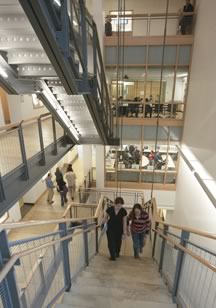
Photo: Bob Handelman
- Classrooms and seminar rooms are distributed throughout the building, so student traffic keeps the building "alive."
- Classrooms and laboratories are designed to maximize flexibility and to accommodate different pedagogical approaches.
- Teaching labs allow the combination of lecture and hands-on activities in a single class session.
- Laboratories are designed to allow students to engage in hands-on research, with student labs and faculty research labs placed near each other. All of Hamilton's seniors are required to complete a research project, and there is also an active summer research program.
- Faculty in different departments are located near each other to maximize interdisciplinary connections in the sciences.
- Student study spaces are arranged throughout the building in close proximity to faculty offices to support access to faculty during informal or ad hoc study periods.
- Up-to-date technology in the building includes network connections made via wireless technology or 1,000 hard ports. Technology is built into all spaces in the building, not just the classrooms and labs.
- The Science Center is environmentally friendly, using a heat-recovery system, geothermal technology in the atrium area, and certified wood (i.e., wood from forests maintained in a sustainable manner) in casework and millwork.
The Building
The resulting 208-gross-square-foot Science Center (20 percent renovation and 80 percent new construction) is a pleasing amalgam of traditional and new elements, blending the stone typical of the existing college architecture with new materials. (See Figure 2.)
Figure 2. Science Center Front Façade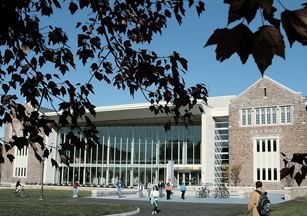
Photo: Peter Finger
The front atrium of the Science Center (see Figure 3) is both the aesthetic centerpiece of the building and an instructional area that highlights green architecture. In this area, air cooled and heated via a geothermal loop system powers a displacement ventilation system integrated with a double-glass façade that serves as the front of the building. A touch screen and flat display explain many green features of the Science Center; sensors provide dynamic information on outside environmental conditions, inside environmental conditions, and operation of the geothermal and heat-recovery systems.
Figure 3. Science Center Main Atrium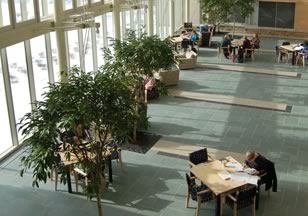
Photo: Marianita Amodio
Classrooms
Each classroom has a touch screen to control projection of computer, DVD, or video images. Of the three tiered classrooms, the largest seats 125 students. This main auditorium (see Figure 4) has a full complement of presentation technologies, including three data projectors, a surround-sound system with speaker microphones, and a separate projection booth with a 16mm projector and additional DVD/VHS and sound equipment.
Figure 4. Science Center Main Auditorium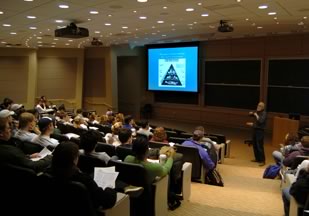
Photo: Marianita Amodio
The remaining two tiered classrooms have two data projectors each without a separate projection booth, but they are fully equipped otherwise. A touch-screen interface controls the rooms' facilities. One of these classrooms is designed with two rows per tier, to make it convenient for students to form discussion groups (see Figure 5) and then return to a lecture format.
Figure 5. Science Center Tiered Classroom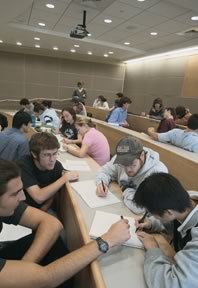
Photo: Bill Denison
Each of the flat-floored classrooms has a single data projector with touch-screen control for all the technologies. To maximize flexibility, classrooms are equipped with standard tables that have wheels at one end so that they can be moved easily for different pedagogical arrangements (seminar, small groups, or lecture). Each of the eight general seminar rooms is equipped with a data projector and computer with a wireless keyboard and mouse that can be passed around as students make presentations.
Laboratories
Laboratories were designed to facilitate specific pedagogical approaches. For example, the geosciences microscope laboratory contains pods with four microscopes each, networked together. (See Figure 6.) When students locate items of interest, they can present to the entire class, and the instructor can project images from two different microscopes onto two wall screens using ceiling-mounted projectors for the class to make comparisons.
Figure 6. Geosciences Microscope Laboratory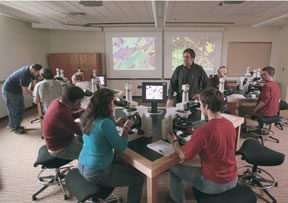
Photo: Bill Denison
Another specialized teaching laboratory clearly visible through windows in the corridor walls is the electron microscopy lab. In addition to two electron microscopes, this lab has a wall-mounted flat-screen display and desktop computers. (See Figure 7.)
Figure 7. Electron Microscopy Laboratory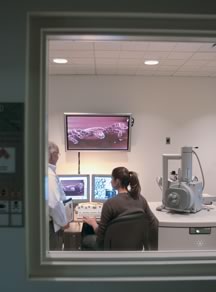
Photo: Bill Denison
Student Study Areas
To make the building effective as a location for student work, many kinds of study areas were included in the design: private study rooms, departmental common areas, and the main atrium. Each set of two to four faculty offices contains a glass-enclosed tutorial area immediately outside (see Figures 8 and 9), where students can wait to see one of the faculty members or work with them. Common areas outside faculty offices are furnished to support student study and tutorial sessions. Wireless technology throughout the building lets students use their laptops in any of these spaces. Additionally, many spaces are configured as effective areas for students to study, either alone or in groups. (See Figure 10.)
Figure 8. Biology Department Student Study Lounge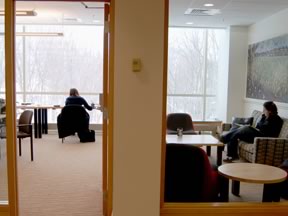
Photo: Marianita Amodio
Figure 9. Biology Faculty Office Tutorial Area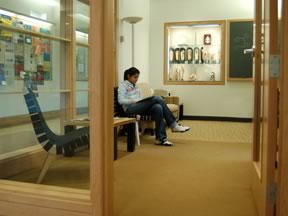
Photo: Marianita Amodio
Figure 10. Student Study Areas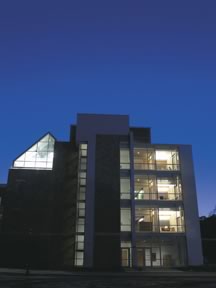
Photo: Bob Handleman
Overall Effect
The combination of aesthetics and effective spaces for learning encourages heavy use of the Hamilton College Science Center by students and faculty from all areas of the campus. The technological support, comfortable areas for individual or group study, and easy access to faculty promote student engagement and learning, contributing to the Hamilton College experience.
About the Authors
Nikki Reynolds is the director of instructional technology services at Hamilton College.
Douglas A. Weldon is Stone Professor of Psychology at Hamilton College.